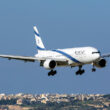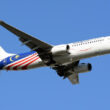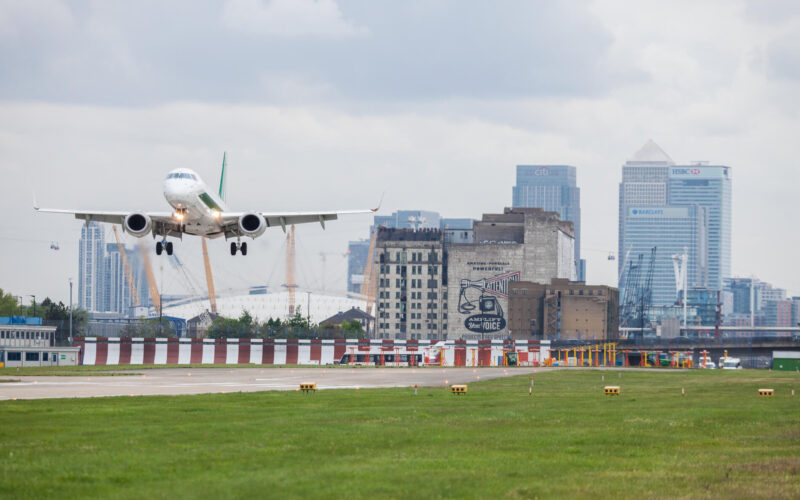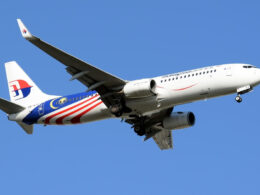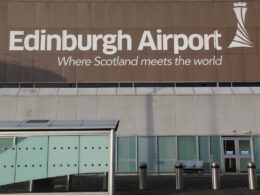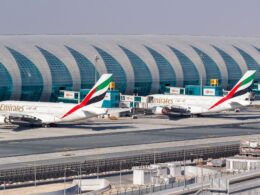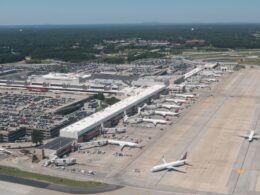At first glance, it could be assumed that London City Airport (LCY), due to its long association as a hub of business travel, should have been acutely exposed to the COVID-19 pandemic. That association stems from the fact that the airport is situated a mere 6.4 kilometres (4 miles) from Canary Wharf, the Capital’s perceived centre of commerce. In fact, during 2019 over five million passengers passed through the city centre airport, making it the busiest 12 months in its 32-year history. Things were looking good for downtown London.
And then, as we are all so well aware, 2020 happened.
Despite deservedly earning the moniker as an annus horribilus, 2020 brought many positives for LCY, with its operators remaining hopeful for a bright future brimming with possibilities. Bolstered by this predicted bright future, in December 2020 the company unveiled a ‘Master Plan’, outlining the airport’s trajectory into the late 2030s when it is envisioned that passenger traffic will be almost doubled.
A rollercoaster ride
In an exclusive interview for AeroTime News, LCY Chief Commercial Officer (CCO), Richard Hill, buoyed by the record-breaking achievements of 2019 had this to say. “It was a very strong year for the airport and we were going into 2020 looking to grow on that further. We could see that everything was pointing towards growth during January and February. From March 2020, the rest became history.”
In a move being duplicated right around the world, the airport had to cease commercial operations from late-March until mid-June. However, unlike many of its contemporaries, LCY remained open for some customers, explains Liam McKay, the airport’s Director of Corporate Affairs (DCA). “The difference in our operations during that period was that we had some Royal Air Force (RAF) test flights or helicopters coming in to model what it would be like if they were bringing people, or equipment into the nearby NHS Nightingale hospital.” The hospital was part of NHS London’s response to the rapidly growing pandemic and opened its doors at the ExCel London Convention Centre in April of 2020.
“Once we restarted operations in early-July, there was a very strong positive uptick of traffic,” said Hill. “I must say it surpassed all of our expectations at that point and demand was very strong.” According to the CCO, at that point almost all air travel was leisure-oriented. “In fact,” he continued, “demand was so strong that, for example, bookings to Ibiza, one of the airport’s most popular leisure destinations, were roughly the same as they were in 2019.
However, 2020 was the year of ups and downs, and as infection cases spiked once again, demand began to crumble. It began to seem like there would be no end in sight. However, and contrary to many common expectations, traffic trends witnessed a surprisingly bright light on the horizon – business travel.
“I think what was interesting for us, though,” remembers the CCO, “the leisure peak going through June, July, August, and then they fall away in September. Our September was actually stronger than August. So, we started to see a mixture of not just [the] leisure travel coming back, but a bit of business, and a bit of visiting friends and relatives continuing to grow towards the winter.”
This upsurge in the demand for business travel came as a surprise for many in the industry – albeit a welcome surprise. Business travel had been perceived as the weakest link during the pivotal travel downturn. The world was rapidly changing, and online video calls were imagined as the alternative to physical meetings, negotiations, and network opportunities. There were even some schools of thought who predicted the almost total demise of business travel, and that this new medium would chime like its final death knell.
The return of leisure and business travel?
The general assumption is that leisure travel will return first before business. Yet the doom and gloom associated with business travel is seemingly overblown.
The London City Airport CCO was keen to point out, that before the onset of the pandemic, business travellers and leisure-oriented passengers using the airport were split at 50/50. Throughout the year, and due to seasonality, the proportion would change. As the winter months rolled on and fewer holidaymakers boarded aircraft at LCY, the company spotted the early signs of deteriorating traffic; it seemed that fewer business passengers were transiting the airport than recorded at the start of the year.
Nevertheless, leisure traffic and visiting friends or relatives (VFR) traffic could be the prime driver once travel conditions improve. “I think we are in a good position to capture that. Certainly, in the short-term, we see leisure and VFR to be stronger than business [travel],” noted Hill.
“The information that we have from our corporate customers, who often use the airport, is that they absolutely do see a need for business travel to return – and they plan to return,” said the CCO. According to Hill, while the London City Airport does anticipate changes in corporate travel, the business travel market will remain an integral part of its’ operations.
According to the airport’s DCA, Liam McKay, the airport surveyed FT&SE companies in the fall of 2020. “To put it into basic terms, when conditions allow, business travel and flying will continue to be really important,” he explained. “It just helps to give a little bit of confidence to the industry, and us in particular, that segment will come back. It’s not going to disappear because of Zoom or Microsoft Teams.”
However, consumers are only one part of the equation, as the situation progressed, the airport remained in active discussions with its airlines. “We took a very long-term view with all of our airlines, and created as much flexibility as we possibly could to allow them to come back when demand returns,” said Hill. The changing international travel policies, like the recently-enacted hotel quarantine in the United Kingdom, is something that will be short-term. While it does provide its own unique set of problems, “we are focused on late-2021 and going into 2022, which I think we are in a strong position for,” according to the airport’s CCO.
The crucial thing moving forward, as noted by McKay, is consistency. “Aviation works when there is certainty and clarity. Obviously, what we have had over the last year is anything but that, and really, looking into the near-term future, we need an understanding and clarity on the future. We were encouraged by Boris Johnson’s roadmap which he outlined on February 22nd, 2021.”
Seemingly, this roadmap has provided much confidence for both the airport and prospective passengers who were eager to begin booking their holidays.
“It not only gave us hope about the summer but also for the huge numbers of Brits who rapidly made bookings for much-deserved summer getaways,” said McKay. Nevertheless, the most important element going forward will be that the British government, together with international partners, “would agree on travel principles that are both easy to understand and, crucially, implement.” If that is done, “then May 17, 2021, can be the date when the European aviation comeback can begin in earnest,” he added.
Another long-haul hub?
While London is currently served by two major international airports, Heathrow Airport (LHR) and Gatwick Airport (LGW), the question frequently pondered is if London City Airport (LCY) could ever join their ranks?
In the past, the airport was serviced by the iconic British Airways BA1/BA2 to New York’s JFK, via the Republic of Ireland’s Shannon Airport (SNN). However, the single, all-business-class Airbus A318 which operated the route, was phased out of the airline’s fleet in March 2020. In late-July 2020, the British airline confirmed that the flight, in its most recent format, would not return.
Despite this, LCY has ambitions to develop some long-haul routes and serve destinations ranging from New York’s JFK, Boston Logan International Airport (BOS), Toronto Pearson International Airport (YYZ), to the Middle East’s bustling hubs of Dubai International Airport (DXB) or Doha Hamad International Airport (DOH).
“Actually, as a result of the COVID-19 crisis, we have definitely seen an increase in appetite for long-haul out of London City Airport,” explained Hill. For one, the onset of new and more efficient aircraft, like the Airbus A220-100 or the Embraer E2 family, would allow airlines to utilise the airport to offer direct connections to such airports. Furthermore, according to the executive, size does make a difference.
“We could see an all-business-class A220-100 with a small cabin operating out of the airport, very similar to a private jet. We have certainly seen interest from airlines and customers alike for such long-haul travel, especially in our airport. Personally, I think there is a favourable view for a smaller airport and smaller aircraft, travelling with fewer people on board and avoiding the large mega hubs. That, I think, is where we see an opportunity,” observed Hill.
That is not to say that the airport is sitting on its laurels and waiting for the opportunities to land on the doorstep. London City Airport has completed the construction of a full-length parallel taxiway and eight new aircraft stands to bolster the number of aircraft taking off per hour. The changes also gave LCY the ability to welcome and service larger aircraft, like the Airbus A220-100, or the Embraer E2 family of aircraft, including the E190-E2 or the E195-E2.
“Historically, airlines had to backtrack along the runway, which meant that we could only handle 39 movements in an hour. This change allows us to handle 45. Thus, it allows us to bring in additional premium slot inventory into the London market, at a time when those peak slots are traditionally quite constrained,” said the CCO regarding the new developments.
These improvements to the airport’s capacity could be coming at a crucial time. Currently, airlines route many flights through hubs, due to the decrease in passenger numbers, the short-term future could be envisaged as a tipping point for direct operations.
“What we are seeing from customers, is that direct flights are absolutely going to be favoured. Especially when we start seeing a proper leisure market return – not only VFR but also proper leisure holiday travellers. We expect a strong favouring towards point-to-point traffic.”
Regarding the post-crisis period – whenever that will come – and most especially regarding whether the industry will see a major shift from a hub, to a point-to-point model, will be “very, very interesting to watch,” concluded Hill.
For an airport that is bracing itself to almost double its capacity over the next two decades, describing the future as interesting may be somewhat of an understatement.
Gearing up for the future
Passenger numbers at LCY have been growing constantly and, despite the pandemic, they are set to grow even further. Gearing up for that growth will be of the utmost importance, as it seems that now, more than ever before, travellers are eager to experience the joys of travel once again.
“We see huge, huge pent-up demand. Our airlines are all reporting strong bookings for the summer. That being said, we don’t see us immediately returning to 2019 levels. We do think that will take a little bit of time, but there will be a big surge in bookings,” commented Hill.
LCY still has some wiggle room in terms of capacity – it finished 2019 with 5.1 million passengers, while the maximum capacity is currently at 6.5 million.
The airport’s Master Plan has predicted that between 2025 and 2030, the airport would welcome approximately 8.6 million passengers per year. To supply that demand, new-generation aircraft, like the A220 or the E2, also bring their own headaches with them. With such aircraft capacity, the 6.5 million passenger limit could be reached long before the airport reaches its maximum aircraft movement capability. This goes to prove that even growth – as welcome as it may seem – can present its own unique set of problems to be considered and solved.
In addition to capacity concerns, the concept of sustainability is also a problematic one. As the entire aviation industry is under ever-increasing pressure to reduce emissions and curb its effects on the environment, the United Kingdom government has pledged to reach a zero-emissions status by 2050. The public has spoken and the aviation industry must step up to those demands. In 2019 a climate-change protester glued himself to the roof of an aircraft, aptly illustrating the challenges facing the entire industry.
“That challenge has not gone away, it’s still there. We still have to address it. The focus now is on how we safely restart the industry and restart in a way that’s consistent and consumer-friendly again,” remarked McKay.
Sustainability has played a key role in the airport’s plans for its future. “Any decision when it comes to infrastructure or even any sort of future growth will be assessed through a sustainability lens going forward,” noted the DCA. McKay highlighted, that previously, the most compelling argument for infrastructure projects were jobs and economic benefit. “That’s still important, of course. But reducing your carbon emissions is absolutely vital,” he added.
“Sustainability had to be front and centre [when the airport drew up its master plan – ed. note] because political stakeholders and an increasing number of public stakeholders want that question to be addressed first,” said McKay. While LCY is a carbon-neutral operation, the DCA had this to add, “But it doesn’t really pass the credibility test for us to say, oh, we’re carbon neutral. You have to be able to talk about the totality of the airport’s operations, which include not only flights but how you get to and from the airport, for example.”
This is where multiple parties should come together and work in unison, rather than sing in disharmony. According to McKay, “Even if you say you’re carbon neutral, someone will ask ‘Well, what about the planes that fly at the airport?’
“We can also remember that airports blamed airlines, while airlines blamed manufacturers. But what we have seen, certainly in the last 18 months, was a recognition that we’re all in it together. We can mutually help each other and collaborate on various initiatives, whether it would be Sustainable Aviation Fuels (SAF), hybrid or electric propulsion,” said the airport’s representative.
Juggling the needs and wants
Unquestionably, airports affect the local community and its residents. On one hand, airports deliver people that spend money and boost the local economy. On the other hand, noise and carbon emissions can have an invisible but detrimental impact. There are also the needs of the passengers to be considered and constantly evaluated. For airport managers, all of these considerations combine to create a never-ending compendium of concerns to be juggled at one time.
Perhaps this is best illustrated in the consultation report attached to LCY’s Master plan. Some questions have showcased how polarising a question can be when presented to two contrasting cohorts.
For example, when the airport asked if residents and passengers would support more flexibility on the number of flights during the first and last half-hours of operations during weekdays, to meet demand – without interfering with the eight-hour nightly curfew – the two groups presented opposing, but not unexpected opinions. 65% of locals surveyed ‘strongly opposed’ the idea, 8% totally ‘opposed’ the idea, while 51% of surveyed passengers were in support, and 28% strongly supported the proposal.
“What you get in these exercises are people who are committed to the topic and are actively participating, while people in the middle typically tend to abstain. All of this means that if you are local and affected, or local and employed, then you are going to share a strong opinion on the matter,” explained McKay. Then there are the passengers, the ones who trust the airport to grow while retaining all the elements that allow them to continue navigating the airport in an efficient and stress-free manner. According to McKay, there will always be “that sort of dichotomy of use between local and passenger.”
While being an airport in the middle of London does bring its unique benefits, it also forces the airport to be mindful of its surroundings. For example, an additional runway was immediately ruled out in the Master Plan, as McKay put it, “there is simply no space.”
Even considering all factors, the future is seemingly bright for the airport. After all, airports are set to dictate the tempo of recovery, not only in travel but also in the general economy once restrictions are lifted.
When asked how airports might play such a role, McKay said, “That could be through job creation, certainly through connectivity, supporting business activity, but also bringing people in. The people we bring in from different places around the world, those are people who pay for hotels, those that people pay in restaurants, go to football games, theatre, so on and so forth.”
Then there is the long-term future, a future that promises aircraft, routes, and passenger numbers as we have never seen before. This great new future may finally shift the way passengers regard the city airport, including its position in the hierarchy of airports already operating in the British capital.

